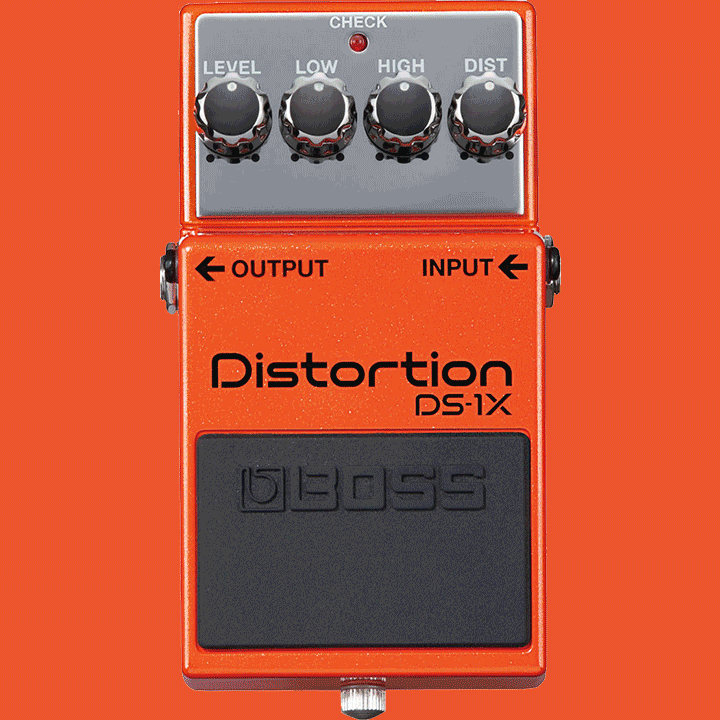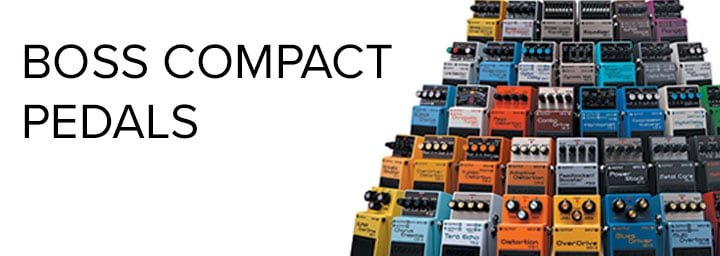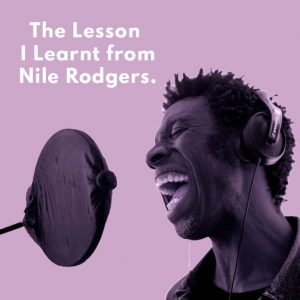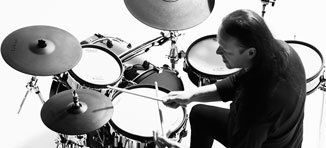Do you know your Flangers from your Phasers? How about the difference between a Vibrato and a Tremolo? This FX-101 is a resource that categorises and explains common guitar effects to find the tone you need.
Contributed by David Jiang for the Roland Australia Blog
INDEX
A – ACOUSTIC SIMULATOR
C – CHORUS, COMPRESSION/SUSTAIN
D – DELAY, DISTORTION
E – EQ
F – FUZZ, FLANGER
G – GATE
H – HARMONISER
L – LOOPER
O – OVERDRIVE, OCTAVE/PITCH SHIFT
P – PHASER
R – REVERB, ROTARY
S – SLICER, SLOW GEAR, SWITCHER, SYNTHESIZER
T – TREMOLO, TUNER
V – VIBRATO, VOCODER, VOLUME
W – WAH
Effects Categories
Before we can even look at effects we need to have a look at the different categories of effects. There are four main categories of effect used to create guitar tones.
Dynamic effect – a type of effect that shapes the volume of your guitar tone.
Time-based effect – a type of effect that changes the playback time of your guitar tone.
Frequency-based effect – a type of effect that alters specific frequencies of your guitar tone
Modelling effect – Many BOSS modelling effects use COSM or Composite Object Sound Modelling, which uses computer-processing power to digitally precisely model the electronic, mechanical, and magnetic characteristics inherent to an instrument, amplifier, or speaker, and also to create completely new sounds. Modelling effects can be dynamic or time-based – it can even make your guitar or amp sound like a completely different type of guitar or amp.
So now that we know the four different categories, let’s have a look at the different types of guitar effects.
Types of Effects
A – Acoustic Simulator
Acoustic Simulator – A modelling effect that makes your electric guitar sound like an acoustic guitar. Different acoustic guitar types can be chosen for a variety of tones.
C – Chorus, Compression/Sustain
Chorus – a frequency-based effect that makes your guitar sound like more than one guitar is playing. The effect is created by doubling your guitar tone one or more times (using a short delay) and then varying the pitch of the double slightly up and down against the dry guitar tone. Chorus pedals have at least two controls: Depth and Rate. The Depth controls the lowest and highest pitches that the doubled tone varies between. The Rate controls the speed that the doubled tone moves up and down in pitch.
Compression/Sustain – a dynamic effect that smooths out the highest and lowest volume levels of your guitar signal to a more consistent level. A compressor also has the side effect of increasing the sustain of your guitar signal. Compression boosts the overall level of your guitar while clamping down on the volume of the loudest parts to prevent clipping. Compressors usually have an attack knob that allows you to control how fast it takes the compressor to start effecting the tone and a threshold knob that sets the volume level that the compressor starts clamping down on peaks.
Pedals: CS-3
D – Delay, Distortion
Delay – a time-based effect that sounds like an echoing of your guitar tone. A delay pedal creates a copy of your guitar tone that repeats like a fading echo. Delay pedals usually have a time knob that allows you to choose the time of the delay intervals, an effect level knob that controls the volume of the delayed sound and a feedback knob that controls how many repeats are sounded before the effect fades. See different types of Delay below:
Analog Delay – A type of delay that uses physical components rather than computer processing to create the delay tone. While you can only get a single type of delay from an analog pedal, the tone of an analog delay is warm and often has slight imperfections that bring the tone to life.
Pedals: DM-2W
Digital Delay – A type of delay that uses digital signal processing in a computer chip to create the delay tone. This processing provides a crisper or cleaner delay tone. Another advantage of a digital delay are that you can emulate characteristics of different delay types in one pedal i.e. tape, analog etc.
Pedals: DD-3, DD-7, DD-500, TE-2
Tape Delay – A type of analog delay made famous by the Roland Space Echo that uses a tape loop running across multiple heads to create the delay tone. Tape compresses the tone and adds a unique timbre that isn’t possible with other delay types.
For a more detailed run down of Tape delay check out our article Demystifying the Magic of Tape Echo.
Pedals: RE-20 (a COSM modeled tape delay pedal).
Distortion – A dynamic effect that sounds like your guitar is being played through a loud, distorted amplifier. This can range from a slight crunch to a full-on metal distortion. The first distortion tones boosted the gain of an amplifier’s pre amp to the point where the guitar signal begins to “clip”. This clipping changes the harmonic structure of the guitar sound and the additional overtones heard as distortion. Connecting distortion pedals to the “front” of the pre-amplifier helps create the break up sound before it reaches the power amp.
Pedals: DS-1, DS-2, MT-2, DS-1X, ST-2, ML-2, MD-2
E – EQ
EQ (Equalizer) – A frequency-based effect that allows you to boost or cut frequencies along the audio spectrum. Graphic EQ pedals such as the GE-7 and GEB-7 have faders for each frequency band that you can move up or down to boost or cut the frequency. EQ pedals can be used to tackle problem frequencies such as mid-range honk or to give a bass boost or add some high end sparkle. Alternatively you can use EQ to create interesting tones such as emulating a small radio by rolling off the bottom end and boosting the high mids.
F – Fuzz, Flanger
Fuzz – A dynamic distortion effect that sounds just like the name. Fuzz was originally created by putting a pinhole or cut in the speaker of an amplifier. Original fuzz pedals use a transistor-based circuit to create the sound. Compared to distortion, fuzz is more raw, abrasive and doesn’t compress the tone. These pedals typically perform best at the front of your effects chain into a clean amplifier.
Pedals FZ-5 (Modeled Fuzz Pedal)
Flanger – a time-based effect likened to the sound of an aeroplane taking off and landing. The “whooshing”effect is created by feeding the output of the guitar tone back in on itself with a very short delay (usually less than 20 milliseconds) causing comb filtering (boosts and cuts along the frequency range). The delay time is then varied which causes the comb filter to move up and down the frequency range.
Pedals: BF-3
G – Gate
Gate – A dynamic effect that cuts off or lowers the volume of the output when the input is below a certain volume threshold. Once the input reaches the threshold the gate opens and allows the entire signal through. This is handy when placed in an amplifier’s effects loop for helping to eliminate hiss caused by high gain distortion when the guitarist is not playing.
Pedals: NS-2
H – Harmoniser
Harmoniser – a frequency-based effect that sounds like a second guitarist is playing in harmony with the original guitar signal. The effect is created by doubling the guitar input signal and then shifting the pitch of the double up or down at a certain interval (usually a 3rd, 5th or octave). The harmony effect is often used in the metal and hard rock genre to play solos.
Pedals: OC-3. MO-2, PS-5, PS-6
L – Looper
Looper – A time-based effect that records a “phrase” of your playing and loops it back repetitively. These phrases can play sequentially in a song-style format or overdubbed to create dense layers, as used by one-man band style performers, vocalists to beatboxers. Larger loop pedals have more than one pedal for multiple tracks and allow you to add in-built effects to your loops. Remember: If you want to record your chain of effects pedals, make sure your loop pedal is always at the end of effects chain.
Pedals: RC-1, RC-202, RC-3, RC-30, RC-300, RC-505, VE-8
O – Overdrive, Octave/Pitch Shift
Overdrive – A dynamic effect that sounds like your guitar tone is being played through an amp breaking up. Overdrives are more subtle than distortion effects. To achieve the original overdrive effect, a valve or vacuum tube amplifier would be “overdriven” by increasing the gain to the limits of the tubes. At this point, the vacuum tube can’t handle the voltage, starts “breaking up”, and adding extra overtones to the signal giving the sound distortion.
Overdrive pedals are generally placed in front of the amplifier to simulate the “break up” at lower levels before it reaches the power amp.
Pedals: BC-2, BD-2, OD-1X, OD-3, ODB-3, SD-1, SD-1W, BD-2W, OS-2
Octave/Pitch Shift – A frequency-based effect that takes the input of your guitar tone and shifts it in pitch anywhere up to an octave above or below. This is useful to simulate a bass guitar line or the higher pitched strings of a twelve-string guitar. Some octave or pitch shift pedals double your guitar tone before shifting making them more akin to Harmoniser pedals.
P – Phaser
Phaser – A frequency-based effect that makes a swirling, swooshing filtered guitar tone. Phasers use the principle of “phase” cancellation in which a filter passes over your guitar tone flipping the waveform at specific frequencies. This signal is then combined with your original guitar tone to give the iconic phaser effect used in songs by Van Halen, Pink Floyd and Smashing Pumpkins to name a few.
Pedals: PH-3
R – Reverb, Rotary
Reverb – a time-based effect that simulates the echoes that occur in a room. This effect was originally created by putting a loudspeaker in a special echo room and recording the result. Some reverbs however, fed sound in to objects like springs or metal plates to generate echoes that are not possible using conventional room reverbs.
For a more detailed run down of reverb sounds check out our Reverb for Guitarists article here: https://rolandindonesia.com/boss-talk-reverb-guitarists/
Pedals: RV-6
Rotary – A modelling effect that recreates the sound of a rotary cabinet amplifier. A rotary cabinet amplifier was originally designed for electric organs as a way to emulate the wobbling sound of a pipe organ by rotating a speaker within its cabinet. However, the effect soon became popular with guitarists as a type of modulation effect. The RT-20 rotary pedal has two speeds, fast and slow. You can control the speed of rotation and the rise time, which is the amount of time it takes to switch between the fast and slow speeds.
Pedals: RT-20
S – Slicer, Slow Gear, Switcher, Synthesizer
Slicer – A dynamic effect that sounds like your guitar tone is chopping in and out. This percussive effect is akin to sequencer-type effects used by synthesizers. The effect turns the volume of the signal on and off, and sounds like the signal is being “chopped up” or “sliced” in a specified pattern. The BOSS SL-20 Slicer features 50 patterns to turn your guitar into a groove machine!
Pedals: SL-20
Slow Gear – A dynamic effect created by BOSS that swells in volume as if you were riding the volume knob on your guitar. The effect is similar to the envelope of a violin with its ability to remove the “attack” or initial transient of the signal and produce gradual volume swells. The compact pedal version of this effect is discontinued but it is found in both the ME-80 and GT-100 multi effects pedals.
Pedals: SG-1 (discontinued)
Switcher – Not an effect but a powerful piece of kit in your pedal arsenal. A Switcher allows you to switch between different effects chains, guitars, amplifiers and more – all at the push of a footswitch.
Pedals: AB-2, LS-2, ES-5, ES-8
Synthesizer – A special kind of effect that either uses your guitars normal pickup tone or the tone from a special 13 pin GK pickup to trigger synthesizer sounds. A guitar synth allows you to turn your guitar into a massive range of real instruments or create new sounds as you would with a keyboard synthesizer.
Pedals: GR-55, GP-10, SY-300, SYB-5
T – Tremolo, Tuner
Tremolo – A dynamic effect that rapidly lowers and raises the volume of your guitar tone creating a wobbly pulsing quality. This effect was found initially in valve amplifiers but soon found its way into compact pedals for more control over the wave shape of modulation (smooth sine-waves vs choppy square-wave), depth and ranges of rate.
Pedals: TR-2
Tuner – Not an effect but a very handy piece of kit in any guitarist’s arsenal. Does what it says, helps to accurately tune your guitar in a noisy gigging environment.
V – Vibrato, Vocoder, Volume
Vibrato – A frequency-based effect that mimics the sound of rapidly vibrating your finger over a string causing the pitch of the note to waver up and down. Vibrato pedals can be used to thicken your tone or at higher depth settings can create surf rock and spacey tones.
Pedals: VB-2W
Vocoder – A synth effect that makes it sound like your guitar is “talking”. A Vocoder takes the input of a vocal microphone and uses the natural formants of the voice to shape your guitar tone.
Pedals: VO-1
Volume – A Dynamic effect that is as simple as it sounds. A volume pedal uses an expression foot controller to raise or lower the volume of your guitar tone. There are many uses for a volume pedal but common usages include lowering your guitar signal to zero in between sets or swelling in the guitar signal for ambient effects.
Pedals: FV-30H/L, FV-50H/L, FV-500H/L
W – Wah
Wah – a frequency-based effect that creates a sound similar to a voice saying “Wah”. A Wah pedal uses a filter that sweeps across the frequency band. In a pedal wah, pressing the toe down will make the guitar signal brighter; heel down makes the signal darker. The filter can be controlled either automatically by electronics within the pedal or manually by the use of an expression pedal giving the guitarist’s hands-free control over their tone.









